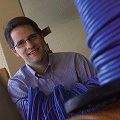2007 Campus Technology Innovators: Virtualized Networks

TECHNOLOGY AREA: VIRTUALIZED NETWORKS
Innovator: Rice University

RICE INNOVATOR
Kamran
Khan on the
university's new
virtualized network:
"We took
a holistic
approach in
architecting
and designing
an
innovative infrastructure
that is future-ready and
does not require a forklift
replacement."
Foregoing traditional switched networking for a
high-capacity, advanced virtualized network
When technologists at Rice University (TX) set out to
upgrade the institution's network in 2004, they decided to
forgo traditional switched networking to leverage carrier class
technology and create a high-capacity, advanced virtualized
network. Along the way, the university constructed a state-ofthe-
art network, along with enterprise storage and a new data
center. Today, Rice is recognized as the first academic institution
to utilize multiprotocol label-switching (MPLS) virtual
private networks (VPNs).
The need for reliability, security, and quality of service was
the driving force behind this project. Working with Cisco
Systems and IBM, Vice
Provost for Information Technology Kamran Khan and a team
of IT researchers created an initial MPLS design and then visited
campus stakeholders to vet the concept, secure buy-in,
and collect additional requirements. The proposal was funded
in spring 2005, and the blueprint for building the infrastructure
revolved around a major overhaul of integral
academic, administrative, and research cyberinfrastructure.
Technology choices. Rice engaged IBM and Cisco to
execute the project on an accelerated timeline. Contractors
were hired through IBM to
install the copper and fiber
infrastructure. As each building
was wired, Rice and IBM
installed the network equipment
and prepared the infrastructure
for client migrations.
As part of the conversion,
technologists migrated data
to BlueArc enterprise storage using disk-to-disk backup technology from
Copan Systems. Elsewhere, teams
installed technology from Sun Microsystems,
CommVault, and Hewlett-Packard.
"The infrastructure was designed in collaboration with our
faculty and students for efficiency, support, future demand,
innovation, management and maintenance, performance, and
cost efficiencies," says Khan. "We took a holistic approach in
architecting and designing an innovative infrastructure that is
future-ready and does not require a forklift replacement."
IT staff served as the first test group to migrate their computers
in the spring of 2006. During the summer, this team
wired residence halls, and students helped identify bottlenecks
in the migration process. For the August move-in weekends,
IT set up temporary help desks in each residence hall to
assist with network connections. During this time, Rice
designed and built a new data center, which was scheduled
to open in July 2007.

RICE UNIVERSITY
Director of Networking,
Telecommunications,
and Data Center Operations
William Deigaard:
"Considering the scope of
this project, it's amazing to
see what we've accomplished
in the past 18 months."
Myriad benefits. Thus far, the system has worked wonders.
Faculty, staff, and students have the same network
privileges regardless of their campus location—wired or wireless.
Researchers can send petabyte files from Rice highperformance
computers to project collaborators all over the
world. Graduate business students can access project data
with laptops from any location on campus. Perhaps most
impressively, cello students can participate in Yo Yo Ma's
Florida master class via high-speed Internet2 videoconferencing.
But there have been other benefits, too. First, Khan says
gigabit connectivity will allow researchers to solve very large
data-intensive problems and submit more competitive grant
proposals. He notes the sophisticated network also will give
Rice an edge with faculty recruitment and retention. The network
will even reduce departmental costs through consolidation
to central servers and services. Finally, the university will
see a greatly reduced risk of data loss with enterprise storage
and the new data center.
Challenges met. Alas, no project is perfect, and the Rice network migration presented
a few surprises along
the way. Khan says the
academic schedule created
challenges for wiring
and desktop migrations in
faculty offices, and he
notes that school technologists
learned the hard way that re-cabling an active research
institution environment cannot be done during daylight hours.
All that is behind the team now; down the road, says Khan,
the next phase will incorporate applications, ePortfolios, web
services, and open source for data collection and system
integration.